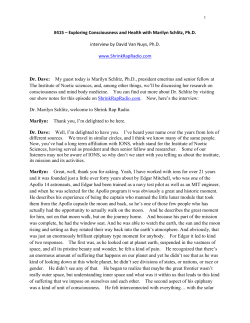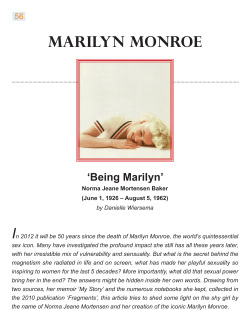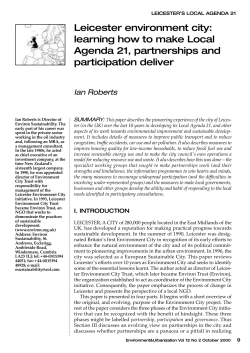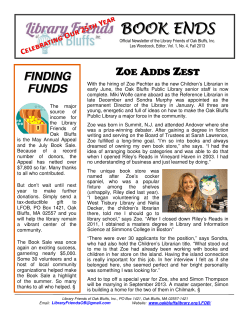
Fun Time’
‘FUN TIME’ A small group activity to develop speaking and listening skills ‘Fun Time’ uses small group situations with activities for developing talking and social skills, attention and listening for children who need extra support in these areas. Timetabled for a regular weekly slot of anything from 10-25 minutes, children can enjoy and benefit from this adult support in a friendly, purposeful atmosphere. These sessions include a mixed ability range of children and the activities can develop and change over time to keep the children interested and motivated. (If your setting is receiving extra funding for speech and language work this is an ideal way to spend it!) © Marilyn Bowles Leicester City Education May 2010 Page 1 Why? Most children learn to relate to other people naturally through playing with adults and other children. They learn that communication between two people requires: eye contact turn taking attention and listening Some children may have difficulties in the following areas: waiting using other children’s names anticipation making choices asking for help coping with winning and losing sitting in a circle next to others limited vocabulary For some children these skills don’t come naturally and need to be taught. Learning through play and enjoyment in a structured, safe and fun session can be a good way for children to experience and practise these skills. Who? The ideal group size is 4 children, with a range of difficulties. Children with age-appropriate social skills can be included to act as a model to the target children in the group. If the children you are focusing on are reluctant or have difficulty with this size of group a start can be made by introducing the session on a 1:1 basis with an adult or with an adult and one other child. A reluctant child may need the freedom to sit on the edge of the group (possibly with adult support) until they are comfortable with joining in. Most children will gradually move into the circle in their own time. Some children will need consistency of group members so aim to keep the group the same. In some instances it would be good to choose particular children the target child is showing an interest in, in order to support developing friendships. © Marilyn Bowles Leicester City Education May 2010 Page 2 Where? A separate or quiet space away from the main group is ideal but if this is not possible a clearly defined area within the classroom will do. Use a small rug or travel blanket, clearly named individual mats or a circle of chairs to indicate who is sitting where. Use the same routine (rug/mat/chairs) each time: this consistency will be very valuable for the children in establishing a comforting routine and expectations. © Marilyn Bowles Leicester City Education May 2010 Page 3 What do you need? Being well prepared and having everything to hand will enable the session to run smoothly. You need the specific props and toys for each session in a box or bag kept next to the adult a visual timetable in the form of a picture strip for that day’s activities a visual support strip for - good looking good listening good sitting good thinking a ‘finished’ box or basket assorted stickers and sticker chart a comment sheets for recording any notable observations It is advisable to keep the resources in a separate Fun Time bag as this will save time and effort © Marilyn Bowles Leicester City Education May 2010 Page 4 Why use a visual timetable? It is important to use the pictures of the session’s activities on a visual timetable and that they are easily visible to all of the children because the pictures ‘explain’ the session and will help the children understand and feel comfortable with what is happening they help to support the sequence of the familiar routine, show the beginning, what will happen next and……..when the end is coming! children like being involved in the whole process: taking pictures off and placing them in the ‘finished’ basket/box and ‘reading’ what is coming next the children can look forward to what is going to happen next rather than not knowing the timetable is very useful for those children finding it hard to sit so that they know how long it is to the end! the shorter strip of ‘behaviour’ pictures are a constant reminder as to what constitutes good behaviour within the group and are referred to at the beginning of each session. © Marilyn Bowles Leicester City Education May 2010 Page 5 A ‘Fun Time’ session In your small group place, encourage the children to sit in a circle. Use another adult if needed so that things are as smooth as possible in the first session. Once you are established you may not need that other person. Always start with the same routine using the ‘Hello’ song with the appropriate picture on your visual strip. Sing: ‘Hello Jasvinder, Hello Jasvinder, Hello Jasvinder and how are you today?’ (Tune: ‘Nice one Cyril’!) Look at Jasvinder while you sing and encourage the other children to do the same. Each child responds to ‘their’ song with ‘thumbs up’ if they are feeling good and ‘thumbs down’ if not feeling so good as they become familiar with this routine the children will be eager to tell you why they feel as they do in both cases! This is to be encouraged. Sing to each child in turn (and encourage them to sing hello to you) and share their responses. Child takes picture from the timetable and puts into the ‘finished’ box/basket © Marilyn Bowles Leicester City Education May 2010 Page 6 Next on the visual timetable: Sing ‘Will you be my friend?’ song Encourage the children to hold hands (assume they will but if someone does not want to, don’t worry, they may join in at a later session). Swing arms gently and sing ‘Will you be my friend and hold my hand? Will you be my friend and hold my hand? Will you be my friend and hold my hand? Thank you very much.’ (Make up your own tune!) A different child takes the picture from the strip and puts into box/basket Then, use a selection of 2, 3 or 4 different activities for the sessions. e.g. ‘Which is your favourite picture - and why?’ © Marilyn Bowles Leicester City Education May 2010 Page 7 After each activity a child takes the picture card off the visual timetable and puts it into the ‘finished’ box/basket ‘What’s in the box?’ At the end of the session sing the ‘Goodbye Song’ to the same tune as the hello song. ‘Good bye Alfie, Goodbye Alfie, Good bye Alfie, we’ve had a lovely time’ (‘Nice one Cyril’ tune) A child then removes the last picture card and then each child chooses a sticker to put on their individual sticker chart. It is great to have a time when this can be done calmly, with lots of time for each child to choose which sticker they want and to talk about his/her choice. © Marilyn Bowles Leicester City Education May 2010 Page 8 All of these activities have the added advantage of introducing lots of new vocabulary to the children which is then used repeatedly and becomes embedded in their talking. After the session write down any assessment observations whilst they are fresh in your mind! On the next 6 pages there are sample sessions of ‘Fun Time’ using the suggestions from the ‘Fun Time’ activity pack for you to use. Kim’s Game NB Ensure that parents know about these sessions (see the Fun Time Parent leaflet) Also make time to explain to the whole staff in the setting what Fun Time is all about so that they understand that this is a useful strategy for ALL ages. © Marilyn Bowles Leicester City Education May 2010 Page 9 ‘FUN TIME’ SUPPORTS ALL OF THE ‘10 KEYS’ CRITERIA! ‘The 10 keys to unlocking language in the Early Years’ Early Years Support Team, Leicester City 1 Welcome each child into your setting as they arrive The beginning of the day is tricky if everyone arrives at once. Staff are trying to befriend and reassure parents and the children may get overlooked. A relaxed, staggered start to the day will allow all of these things to happen: each is vital for family progress. 2 Create opportunities to talk and listen to each child Having extended times for child-initiated tasks with an adult working alongside the children gives many opportunities for commentary and befriending. 3 Have a conversation with each child every day Going for walks together, sharing books, talking about something a child has brought in allows for conversations to happen. This may not be possible every day although encouraging parents to do this daily will help each child. Ensure that it happens weekly at least; all of the Circle Time sessions and small group times allow for this. 4 Model good listening and conversation skills We need to put down the clip board and make eye contact, look interested, smile encouragingly, use facial expression and gesture. 5 Value what the child says and not how they say it If you are brave enough to talk in front of everyone then it needs to be acknowledged so praise and encouragement are vital for the shy, reluctant speaker. For those very willing to speak who may indeed speak all the time there are social skills to be learned about taking turns and listening. Praising their listening and patience is vital too! © Marilyn Bowles Leicester City Education May 2010 Page 10 6 Repeat the same story throughout the week Some children need to develop their memories to help them learn new vocabulary. Every child who enjoys something, from the youngest infant onwards loves to say ‘Again!’ They like the anticipation, the sad parts, the happy endings, the funny phrases and repeated use helps them to remember. 7 Keep story groups small and match the story to the children’s needs It is so much easier to enjoy stories in small groups as the leader can make eye contact with individuals, listen to comments without losing the thread of the story-line and sit closer to everyone. 8 Have a plan for teaching songs, rhymes a poetry It must be a wonderful feeling for a child to feel confident that ‘Here comes something that I know!’ Building a repertoire of songs, rhymes and poetry embeds all the new and interesting words which they can try out with confidence in this friendly, comfortable setting. 9 Use explicit language to describe and encourage appropriate behaviour Well done! You are clever! Great singing! Fantastic remembering! Thank you for waiting! 10 Parents understanding the value of talking Hold workshops, send home fliers, talk to parents about how important talk is: see the parents’ letter in this folder. The ‘reward’ referred to in this letter can be anything: a scrapbook for their child’s work, a gel pen, something which says ‘You’re great to get involved with your child’s learning!’ © Marilyn Bowles Leicester City Education May 2010 Page 11
© Copyright 2025







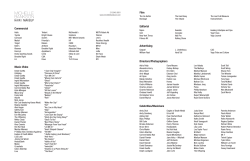
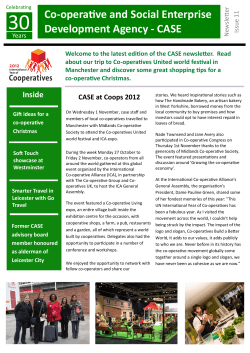
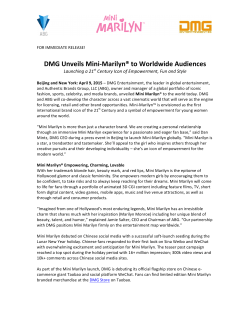

![Hospital Hopper Timetable [pdf / 2.57MB]](http://cdn1.abcdocz.com/store/data/000715556_1-d4fbe6df54170241fd9e46986d657241-250x500.png)
